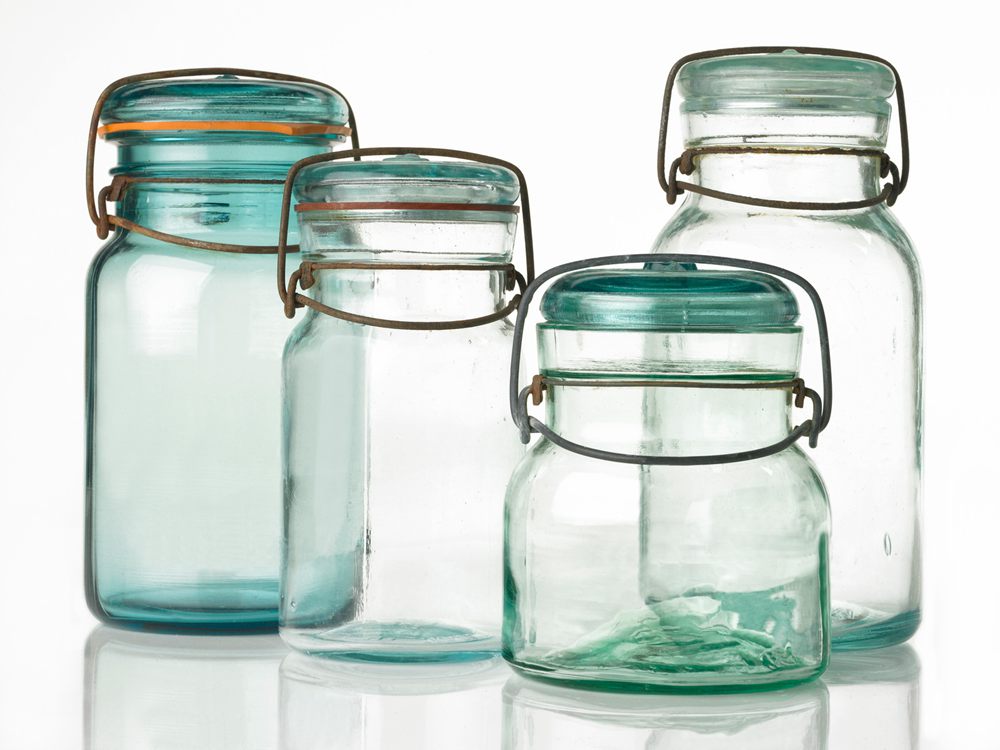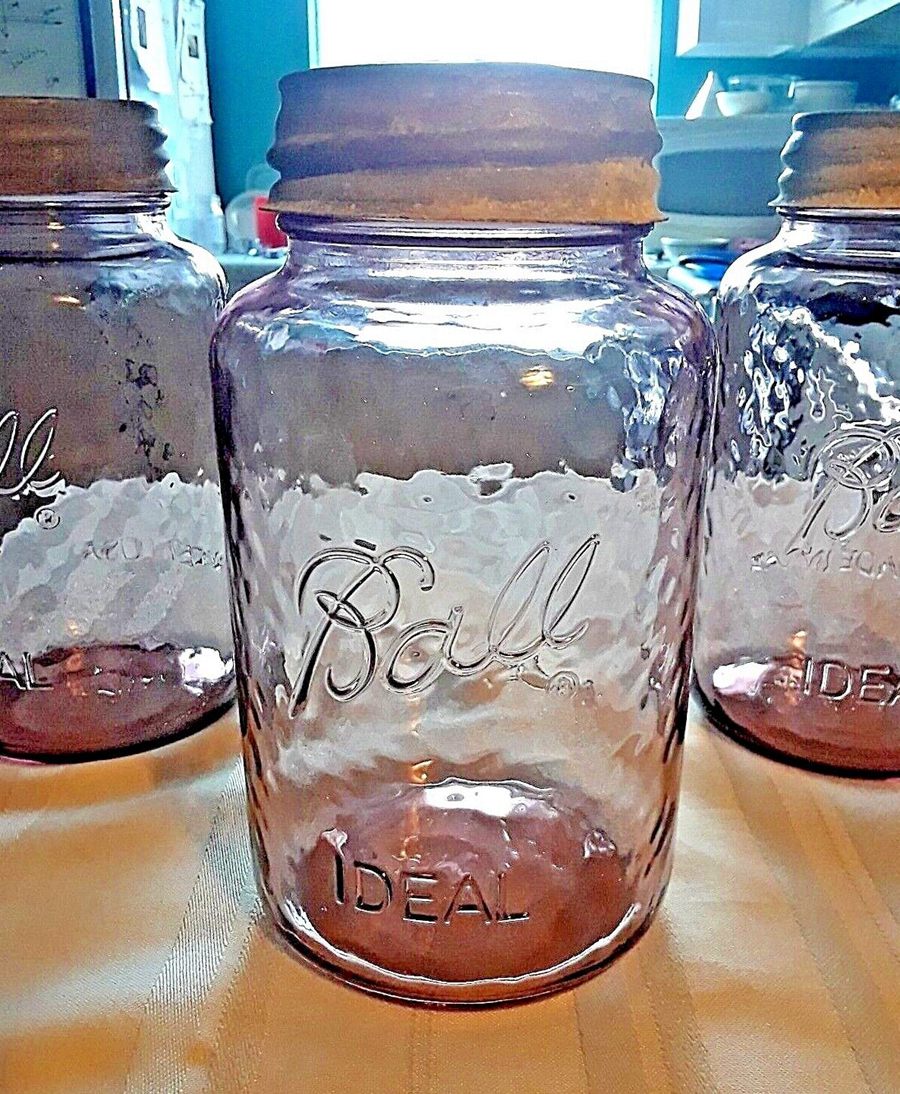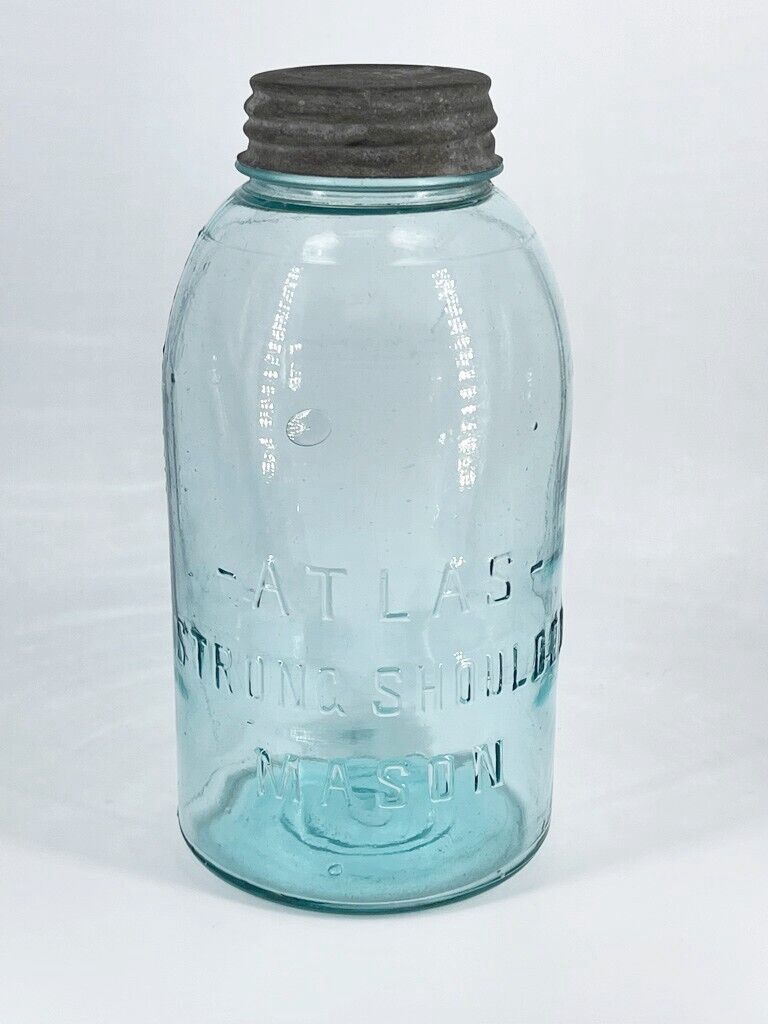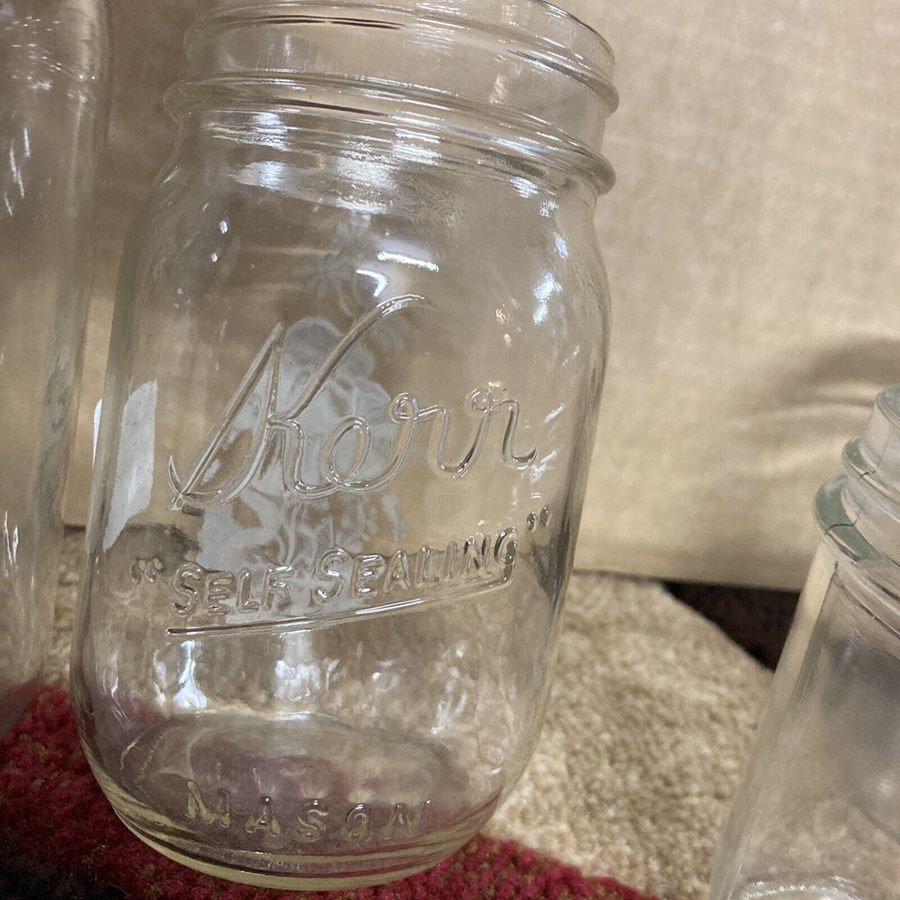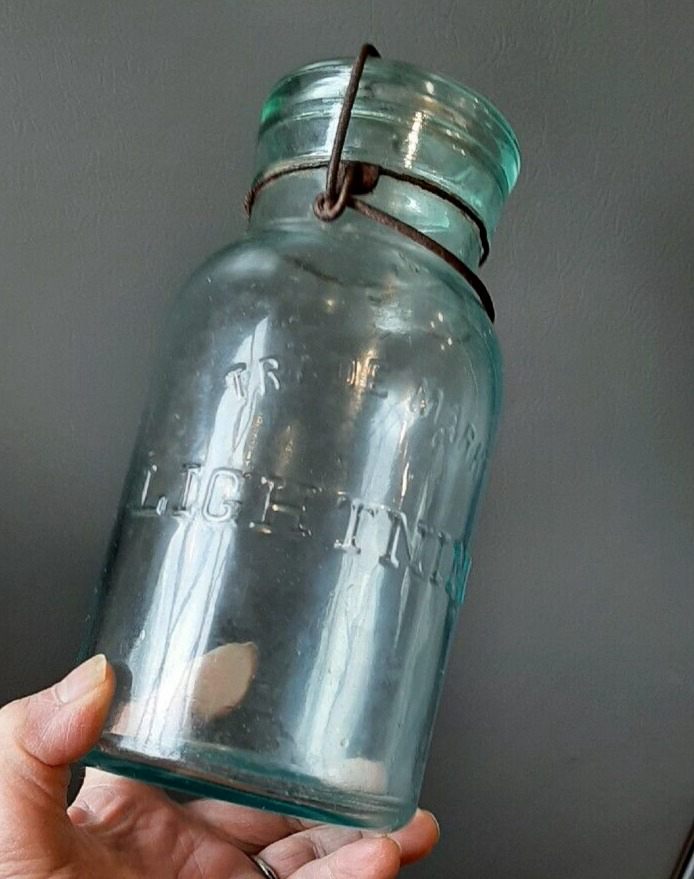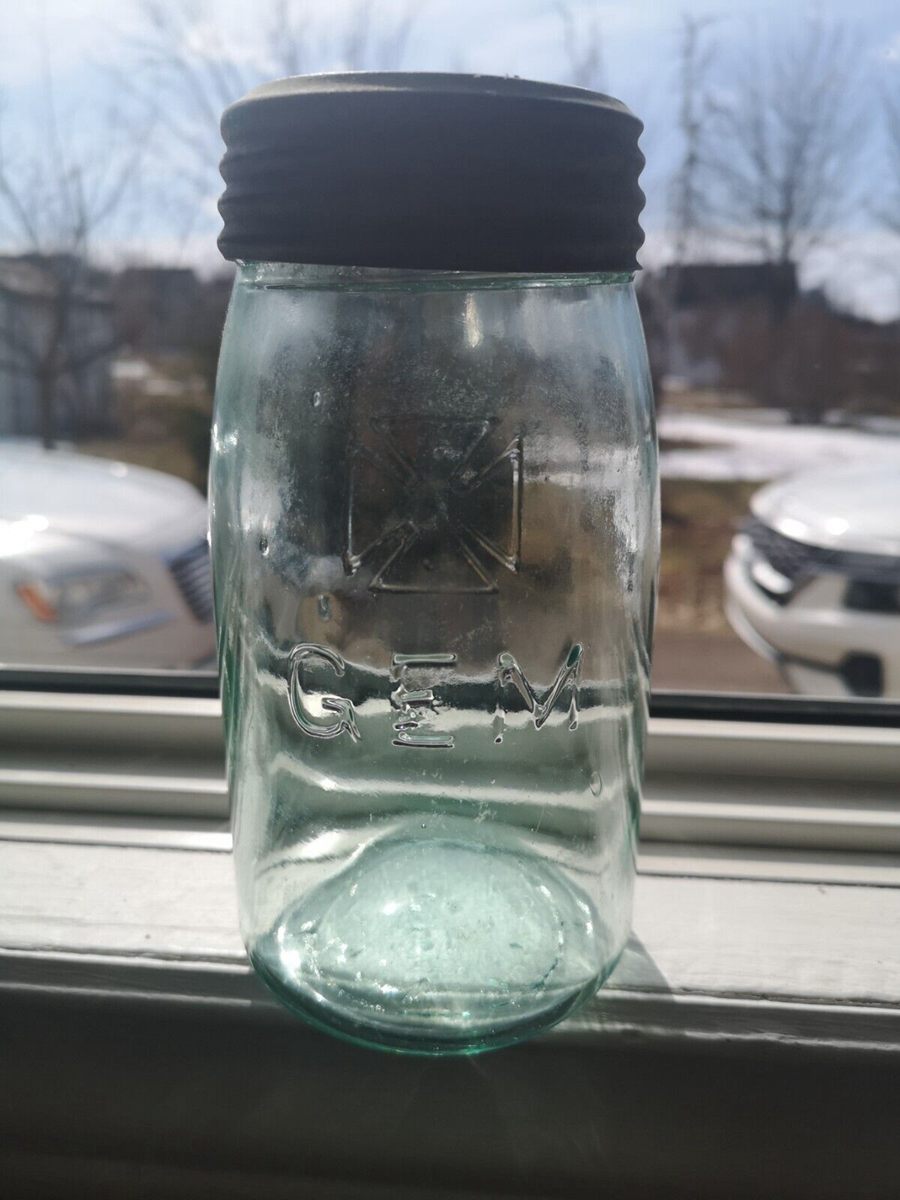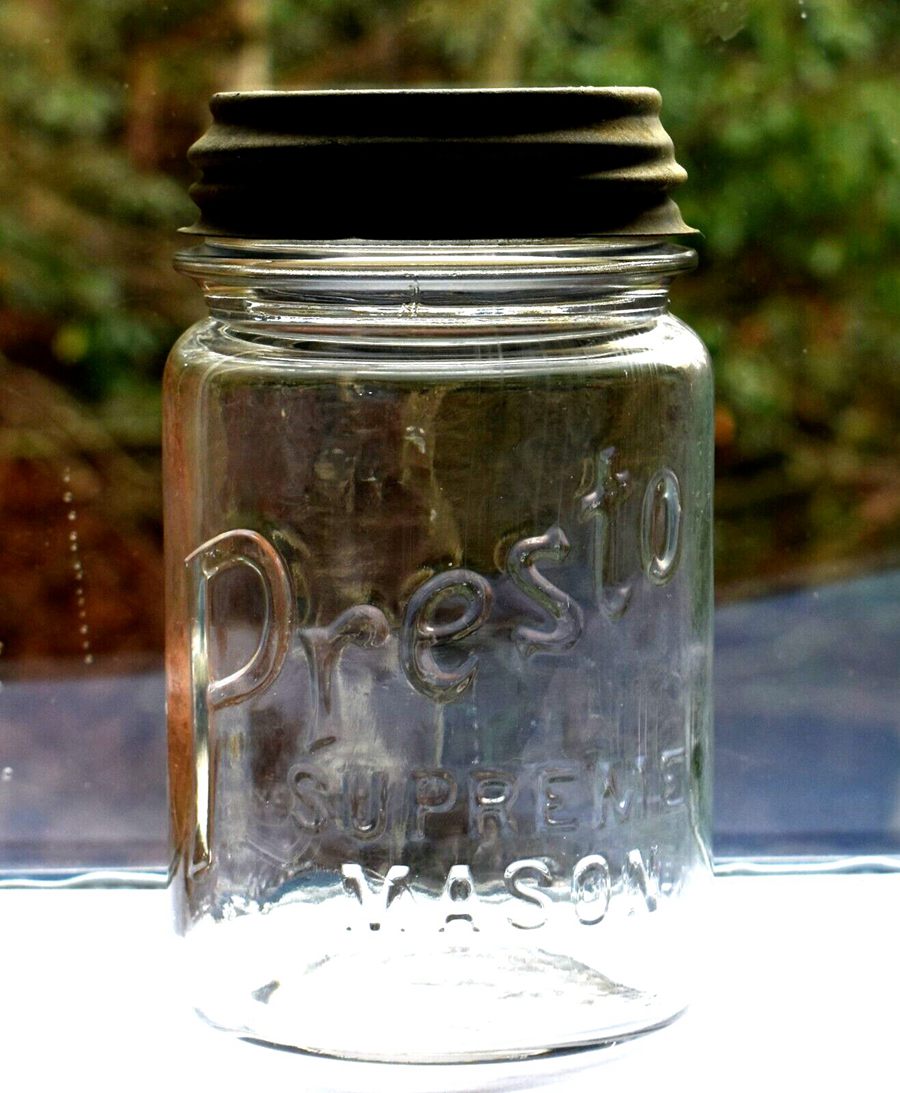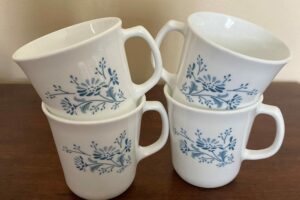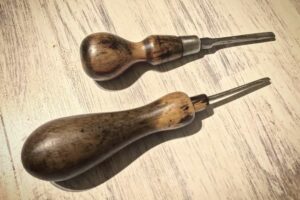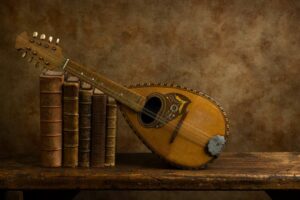Antique canning jars have a nostalgic charm that continues to captivate collectors and enthusiasts alike. As you dive into the world of antique Mason jars, you’ll be delighted by their varying shapes, sizes, and colors, each with its unique features and history. Whether you’re an avid collector or simply interested in the story behind these jars, understanding how to identify and determine the value of antique canning jars is essential.
You will come across various types of antique Mason jars, and familiarizing yourself with their specific features will help you in the identification process. Look for key details such as the type of jar, the logo, color, size, and other distinguishing marks to accurately date the jar. For instance, paying attention to the Ball Mason jar logo can give you a general idea of its manufacturing date. Additionally, noting the presence of unique phrases and words on the jar will also serve as a valuable clue in determining its age.
In your journey to uncover the fascinating story behind antique canning jars, knowledge of their history, as well as a keen eye for detail, will greatly aid your understanding of their value. As you acquaint yourself with the different types of Mason jars and their distinguishing traits, you’ll develop a deeper appreciation for these simple yet timeless pieces as both practical canning tools and treasured collectibles.
Table of Contents
The History & Evolution of Antique Canning Jars
In the early 19th century, you would find preserving food was a crucial skill to ensure a stable food supply throughout the year. The invention of canning jars revolutionized the process, making it easier for you to store fruit, vegetables, and other perishables. As time progressed, various improvements were made to the design and materials used, resulting in the antique canning jars you see today.
The first canning jars emerged around 1809, when inventor John Landis Mason patented the Mason jar. His innovative design integrated a threaded screw top with a rubber seal to create an airtight container for food preservation. You would find this jar design vastly improved storage capabilities and extended the shelf life of preserved goods.
Over the years, other jar designs and innovations appeared, such as:
- The Lightning jar (invented by Henry William Putnam in 1882): This jar featured a bail-type wire closure and glass lid that secured with a metal clamp, providing a reliable seal.
- The Atlas E-Z Seal jar (introduced around 1900): These jars showcased a glass lid with a heavy wire bail that locked down on the outside of the jar. This design innovation effectively sealed the jar without the need for a separate cap or screw-on lid.
- Ball jars (produced by the Ball Corporation in 1885): Recognized as one of the most popular canning jar brands, these containers were made from high-quality glass and featured a variety of designs and closure styles over time.
Knowing the history of antique canning jars helps you appreciate their evolution and value. When assessing the value of specific jars, consider factors like age, rarity, manufacturer, and color. Rare colors or embossed designs can increase the value of a jar.
In summary, understanding the history and evolution of antique canning jars will enable you to identify and appreciate their value. As you explore the world of canning jars, you will uncover a fascinating and practical aspect of history.
How to Tell If Canning Jars are Antique or Old
To determine whether your canning jars are antique or old, you should inspect them closely for specific characteristics. Keep in mind the following aspects while examining your jars:
Closure Type
Look at the type of closure on your jar. Old jars typically used a glass lid held in place by a wire bail or a zinc lid with a glass insert. If the jar has one of these closure types, it might be an antique.
Lettering and Logos
Check the lettering and logos on the jar’s body. Antique Mason jars often have the brand name engraved with unique fonts and styles. For example, Ball Mason jars have gone through several logo changes over the years—pay attention to details like the presence of an underscore or alterations in capitalization.
Color
Examine the color of the jar. Antique jars are typically found in colors like aqua, green, or amber. Clear jars, although less common, can also be found among antiques. Remember that unusual colors often indicate a higher value.
Base Marks
Inspect the base of the jar for any markings, which can provide clues to its age. For instance, pontil marks or indented rings indicate that the jar was hand finished by a glass blower. This is a feature commonly found in jars made before the Civil War.
Mold and Production Marks
Look for mold and production marks on your jar. Older jars may have imperfections, such as bubbles, raised glass lines, or uneven glass thickness. These inconsistencies can be an indication of their antique status.
By considering the closure type, lettering and logos, color, base marks, and mold and production marks, you can make an informed estimation about whether your canning jars are old or antique. Remember that jars with unique features or rare colors may be more valuable.
9 Styles of Antique Canning Jar and Their Values
Mason Jars
Mason jars were patented by John Landis Mason in 1858 and became a popular choice for preserving and storing food. Value of these jars depends on the rarity, color, and embossing. Look for unique embossed logos or unusual colors like amber, olive green, or red-tinted glass to increase value. The shoulder seal jars with “Mason’s Patent Pending Nov. 30th 1858” were machine made between 1890-1915 and can fetch a decent price depending on their condition.
Ball Jars
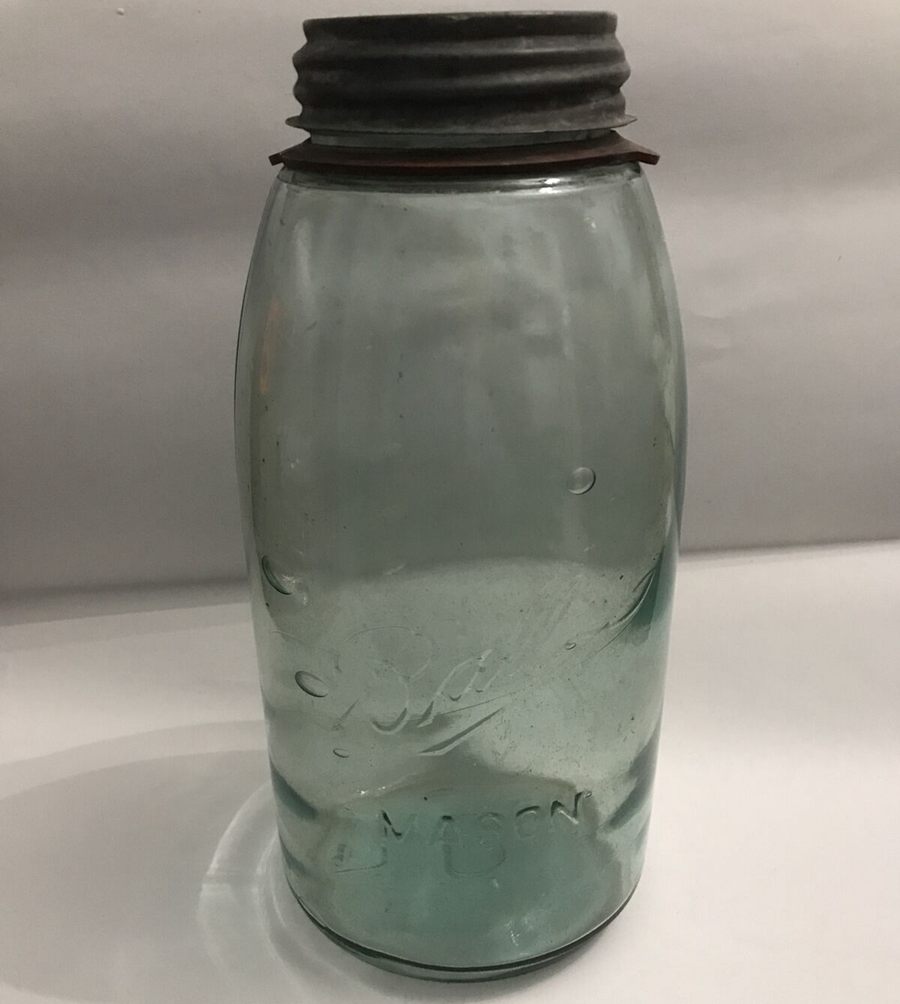
Ball jars are one of the most recognized brands of vintage canning jars. Aqua Ball quart jars made from 1900-1910 with shoulder seals are worth $15-$18, while half-gallon jars made from 1910-1923 with the same seal can be worth $25-$30.
Atlas Jars
Atlas jars were made by the Hazel-Atlas Glass Company, which operated from 1902-1964. Aqua Atlas Strong Shoulder Mason quarts with a bead or ledge seal from around 1920 can be worth $10-$12.
Kerr Jars
The Kerr jar brand was introduced by the Kerr Glass Manufacturing Company in 1903. The Self-Sealing jars are quite popular with collectors. Value depends on factors such as rarity, age, color, and condition.
Lightning Jars
Lightning jars were invented by Henry Putnam in 1882 and featured a wire bail closure system. The Ball Lightning jar is a popular variety, and its value depends on factors such as rarity, size, and color.
Hazel-Atlas Jars
Apart from the Atlas jars, the Hazel-Atlas company also produced a variety of other canning jars. These jars can range in value depending on the model, rarity, and condition.
Crown Jars
Crown jars are Canadian-made jars that were produced from 1880 to the present day. Their value depends on factors like rarity, color, and logo variations.
Gem Jars
Gem jars are another type of Canadian-made canning jars, produced from the late 19th-century to the mid-20th-century. Value is influenced by rarity, color, embossing, and condition.
Presto Jars
Presto jars were made by the Owens-Illinois Glass Company from the 1920s to the 1950s. These jars have a variety of markings, and their value depends on factors like rarity, color, and embossing.
Keep these factors in mind when assessing the value of your antique canning jars. The rarer the jar, the more valuable it will be. Make sure to consider condition, color, and embossing to determine your jar’s worth accurately.
10 Factors to Identify & Value Antique Canning Jars
1. Age
The age of antique canning jars plays a significant role in their value. When determining the age of a jar, there are a few key factors to consider:
- Manufacturing marks: Examine the bottom of the jar for pontil marks or indented rings. These indicate that the jar was hand-finished by a glass blower and were often found on jars made before the Civil War.
- Phrases: Older jars may have phrases like “improved,” “special,” “perfect,” “sanitary,” “ideal,” “square,” and “eclipse.” These can help identify the year of production. For instance, a Ball Mason jar with the phrase “perfect” on the bottom would be from approximately 1913-1922.
- Glass quality: Antique Mason jars have isolated micro-bubbles in the glass and are typically thicker than modern jars. This is why they have lasted for so many years.
Now, let’s take a look at a valuation table for the age of antique canning jars:
| Age of Jar | Average Valuation |
|---|---|
| Pre-Civil War (before 1861) | $250 – 350 |
| Late 1800s (1861-1899) | $100 – 150 |
| Early 1900s (1900-1920) | $75 – 100 |
| Mid-1900s (1921-1950) | $50 – 75 |
| Late 1900s (1951-1999) | $30 – 50 |
Keep in mind that these values are rough estimates and can vary based on the condition, color, and other factors. However, this table provides a good starting point for understanding how the age of an antique canning jar can impact its value. As you evaluate your jars, consider these age factors to help determine the true worth of your collection.
2. Brands
Throughout history, several brands have produced antique canning jars, with each brand having unique features that affect their value. Some of the notable brands include Ball, Atlas, and Mason. Let’s take a closer look at each of these brands and how their jars are valued.
Ball
Ball is one of the most recognizable brands in antique canning jars. They were known for their distinctive “Ball Blue” color, which came from the minerals in their sand. This blue color is highly sought-after among collectors, which increases the value of these jars. The Ball Lightning Jar is a particular favorite among collectors.
| Ball Jar Type | Average Valuation |
|---|---|
| Aqua Ball Quart, Shoulder Seal | $15-18 |
| Aqua Ball Half Gallon, Shoulder Seal | $25-30 |
Atlas
Atlas jars, produced by the Hazel Atlas Company from 1902-1964, are another popular choice for collectors of antique canning jars. The company introduced the Atlas Strong Shoulder Mason jar, which had a bead or ledge seal. These jars come in a beautiful aqua hue and are known for their durability.
| Atlas Jar Type | Average Valuation |
|---|---|
| Aqua Atlas Strong Shoulder Mason Quart | $10-12 |
Mason
Mason jars revolutionized the canning process, thanks to John Mason’s patent for the threaded lip and matching zinc lids in 1858. The threaded design and rubber ring allowed for an airtight seal, ensuring the safety and preservation of food items. These jars are highly sought-after by collectors due to their historical significance.
| Mason Jar Lettering | Date Range | Average Valuation |
|---|---|---|
| Small Lettering | c. 1890 | $15-18 |
| Large “Triple L”• | c. 1900-1910 | $15-18 |
3. Color
When evaluating antique canning jars, the color of the jar is one of the significant factors that affects its value. Most early canning jars are available in transparent, aqua, or dark blue colors. However, if you want to fetch a higher price, you should look for jars in more unique colors. These rare jars can command higher prices due to their scarcity and demand among collectors.
The rarer the color, the more valuable the jar is. Here’s a breakdown of the average valuation of canning jars based on their color:
| Jar Color | Average Valuation |
|---|---|
| Amber | $100 – $120 |
| Red | $150 – $200 |
| Purple | $120 – $150 |
| Black | $200 – $250 |
| Two-tone | Up to $200 |
Ball Mason Jars and Colors
Ball Mason jars, in particular, are renowned for their distinct colors. The company produced jars in various colors, including clear, pale blue, yellow, amber, olive, and other shades of green. Among these, the rarest colors are green-lined jars, which can fetch upwards of $300. Ball’s blue glass jars were mainly produced in the late 1890s and early 1900s, with production ending in 1937.
As a collector, it’s vital to familiarize yourself with the colors and valuations associated with antique canning jars. Understanding the impact of color on the jar’s value will help you make informed decisions when buying or selling these treasured items. Keep in mind that these values are average estimations and may vary depending on other factors such as condition, brand, and rarity.
4. Mold Type
When identifying antique canning jars, one crucial factor to consider is the mold type used during the jar’s manufacturing process. Different mold types can significantly impact the jar’s value and can be used to authenticate the jar’s age.
There are two primary mold types involved in producing canning jars: mouth-blown and machine-made. Let’s explore the specifics of each mold type and their impact on the jar’s value.
Mouth-Blown Mold
Mouth-blown molding was a technique used for producing glass canning jars in the late 19th and early 20th centuries. These jars were crafted by skilled glassblowers who used blowpipes to shape the molten glass. As a result, mouth-blown jars exhibit subtle irregularities, such as slightly uneven jars and more pronounced mold seams.
Mouth-blown jars are often more valuable due to their rarity and historical significance. The following table provides a valuation range for different mouth-blown antique canning jars:
| Mouth-Blown Jar Type | Average Valuation |
|---|---|
| Aqua-tinted | $20 – $50 |
| Amber | $60 – $100 |
| Green | $80 – $120 |
| Purple or Red | $100 – $200 |
Machine-Made Mold
Machine-made molds started appearing in the early 20th century, replacing the mouth-blown molding technique. Jars produced using this method have uniform shapes and thinner mold seams. The precision of machine-made jars increased over time, with earlier jars still showing some irregularities compared to later production.
Machine-made jars may not be as valuable as mouth-blown jars, but certain factors can still influence their worth. The table below outlines the valuation range for various machine-made antique canning jars:
| Machine-Made Jar Type | Average Valuation |
|---|---|
| Clear Glass | $5 – $15 |
| Pale Blue or Yellow | $10 – $25 |
| Amber | $20 – $50 |
| Green or Olive | $30 – $60 |
To summarize, when evaluating the value of an antique canning jar, the mold type is an essential element to consider. Both mouth-blown and machine-made jars have distinctive features that can influence their appraisal.
5. Embossing
Embossing can have a considerable impact on the value and identification of antique canning jars. The embossed features on a jar, such as the manufacturer’s logo or patent dates, provide important clues to its age and origin. As a collector, it’s essential to treat these embossed details with care, as they can reveal a lot about your jar’s history and worth.
The embossing on antique canning jars can vary widely, with manufacturers using different fonts, styles, and logo designs to differentiate their products. One famous example is the BBGMC logo found on Ball jars produced between 1880 and 1890. By studying the details of the embossing on your jar, you can determine its age and potentially increase its value.
Here’s a table summarizing the average valuation of antique canning jars based on different types of embossing:
| Embossing Type | Average Valuation |
|---|---|
| Unique BBGMC Logo (1880-1890) | $200 – $300 |
| MASON’S PATENT NOV 30TH 1858 | $100 – $150 |
| Ball Logo (Various styles and dates) | $50 – $100 |
| Putnam or Presto Manufacturer’s Mark | $30 – $50 |
| No Embossing (Unmarked) | $20 – $30 |
Remember to inspect both the front and the back of the jar to gain more insight into its background. Keep in mind that color may also play a role in determining the value of your antique canning jar. For instance, green jars are quite rare and can be worth upwards of $300 per jar.
As you explore the world of antique canning jars and seek to understand their worth, paying attention to embossing is a crucial step in evaluating your collection. By taking the time to study these markings, you’ll develop a well-rounded understanding of your antique treasures and their value.
6. Shape
When identifying and valuing antique canning jars, the shape of the jar plays a significant role in determining its worth. Different shapes can indicate the age, rarity, and desirability of a particular jar. In this section, you will learn about some popular shapes and their impact on the value of antique canning jars.
- Mason Jars: These jars, named after their inventor John Landis Mason, are the most common and widely recognized shape of canning jars. Their distinctive design includes a screw-on lid and a square shoulder, giving them a sturdy appearance. These jars vary in value, with the common Mason jar fetching around $10-$25. However, rare shapes or patented models can be valued up to $50 – $120.
- Lightning Jars: Invented in the 1870s, these jars are characterized by their glass lid secured with a metal wire bail. Their unique shape and design make them an interesting and valuable collector’s item, with some fetching higher prices depending on rarity and color.
To help you better understand the value of antique canning jars based on their shape, here’s a table summarizing the average valuation:
| Antique Canning Jars Shape | Average Valuation |
|---|---|
| Mason Jar (Common) | $10 – $25 |
| Mason Jar (Rare/Patented) | $50 – $120 |
| Lightning Jar | Variable |
Keep in mind that these values are not set in stone, and the specific value of your jar will vary depending on factors like age, condition, and rarity. Always consult with a professional appraiser for an accurate assessment of your jar’s worth.
7. Closure Types
When identifying antique canning jars, the closure type plays a crucial role in determining the jar’s approximate age and value. Over the years, various closure styles have been employed to preserve food items inside jars. Let’s discuss some of the notable closure types and their approximate values.
Wax Seal or Cap
Wax seals were widely used in the early days of canning. These jars would require the user to pour hot wax around the lid’s perimeter to create the seal. Since these jars became obsolete once newer closure types were introduced, their value comes from their historical significance:
| Closure Type | Average Valuation |
|---|---|
| Wax Seal or Cap | $30 – $50 |
Mason’s Patent Caps
Mason jars with Mason’s Patent caps date back to the 1858 patent by John Landis Mason. These caps are an essential factor when identifying the jar’s age. There are various patents and trademarks within this category, and their approximate values are:
| Closure Type | Average Valuation |
|---|---|
| Mason’s Patent (1890) | $20 – $40 |
| Mason’s Special (1910-1913) | $15 – $30 |
| Mason’s Sanitary (1913-1915) | $12 – $25 |
| Mason’s Perfect (1913-1922) | $10 – $20 |
| Mason’s Eclipse (1926-1952) | $8 – $18 |
| Mason’s Ideal (1915-1962) | $5 – $15 |
Lightning Closures
Lightning closures were used on various canning jars, including Atlas jars, in the early 20th century. Due to the closure’s simplicity and effectiveness, jars with lightning closures continue to be popular among collectors:
| Closure Type | Average Valuation |
|---|---|
| Lightning Closure | $25 – $50 |
Keep in mind that these valuations are only approximate as the condition, color, and rarity of the jar significantly affect the actual value. Your jar’s closure type is just one crucial element to consider during the identification and appraisal process.
8. Lid Embossing
Lid embossing is an essential aspect to consider when identifying and evaluating antique canning jars. Unique and distinctive embossments not only add to the jar’s visual appeal but also significantly impact its value. In this section, we will examine the effect of embossed lids on the overall appraisal and value of these antique jars.
Vintage lid embossments can vary greatly, with some featuring decorative patterns, logos, or brand names. These markings can be indicators of rarity, which can directly impact the jar’s value. Collectors often seek out exceptional embossments, as they may represent limited production runs or specific time periods.
Here is a table listing common lid embossments found on antique canning jars and their approximate average valuation:
| Lid Embossment | Average Valuation |
|---|---|
| Decorative Patterns | $30 – $50 |
| Brand-specific Logos | $25 – $45 |
| Minimal or No Embossing | $15 – $25 |
| Unique Limited Production Markings | $50 – $100 |
Keep in mind that these valuations are approximate and may vary depending on factors such as jar color, size, and overall condition. However, the impact of lid embossing on the value of antique canning jars is clear: jars with unique and distinctive embossments typically command higher prices in the collector’s market.
As you evaluate and identify your vintage canning jars, pay close attention to the lid embossments, as they can play a crucial role in determining the jar’s value. By understanding the significance of these markings and their potential impact on the jar’s market worth, you can make informed decisions about your collection and future acquisitions.
Conclusion
In conclusion, the identification and valuation of antique canning jars depend on several factors. These factors include the brand, logo, embossing, color, and age of the jar. By understanding how these factors impact the value of antique canning jars, you can better appraise and collect them for your collection.
The following table provides an average valuation of antique canning jars based on certain characteristics:
| Characteristics | Average Valuation |
|---|---|
| Ball Mason with “perfect” embossing, 1913-1922 | $50 – 70 |
| Antique Mason jar with micro-bubbles in glass | $40 – 60 |
| Atlas jars in rare colors (e.g., amber, black, etc.) | $75 – 100 |
| Vintage Mason jars with unique shapes or designs | $60 – 85 |
Remember, these are general valuations and may not reflect the current market demand or the specific value of a particular jar in your possession. Always consult with experts or reputable online resources when appraising your items.
By carefully considering these factors and using the information provided in this guide, you will be well-equipped to assess the value and identify your treasured antique canning jars. Happy collecting!
FAQ
What factors impact the value of antique canning jars?
There are several factors that can affect the value of antique canning jars. Some of these factors include the age of the jar, the color, and any unique design elements or logos.
How does the age of an antique canning jar affect its value?
Older canning jars generally have more value because they are rarer and more difficult to find. Early to mid-19th-century jars are often considered the most expensive and valuable.
How does the color of an antique canning jar affect its value?
Mason jars were manufactured in various colors, including clear, pale blue, yellow, amber, olive, and other greens. The rarest jar colors are green, which have been known to fetch upwards of $300 per jar. Darker shades of glass were believed to prevent food from spoiling as quickly in the early 1900s, contributing to the production of various colors.
How do unique design elements or logos impact the value?
Antique canning jars often have unique design elements or logos that help to date them and add to their value. For example, Ball Mason Jars have unique words that signify the manufacturing year of the jar as follows:
- 1910-1913: SPECIAL
- 1913-1915: Sanitary
- 1913-1922: Perfect
- 1926-1952: Eclipse
- 1915-1962: Ideal
Here’s a valuation table to indicate the average price range for various factors.
| Factor | Average Valuation |
|---|---|
| Rarest color: Green | $300+ |
| Unique design/Logo: SPECIAL (1910-1913) | $200 – 250 |
| Unique design/Logo: Sanitary (1913-1915) | $150 – 200 |
| Unique design/Logo: Perfect (1913-1922) | $100 – 150 |
| Size: Cylindrical form | $100 – 120 |
| Size: Round-cornered squares | $70 – 80 |
Keep in mind that these prices are just estimates, and many factors can impact the value of your antique canning jars. Always consult with an expert to determine the precise value of your specific jar.

